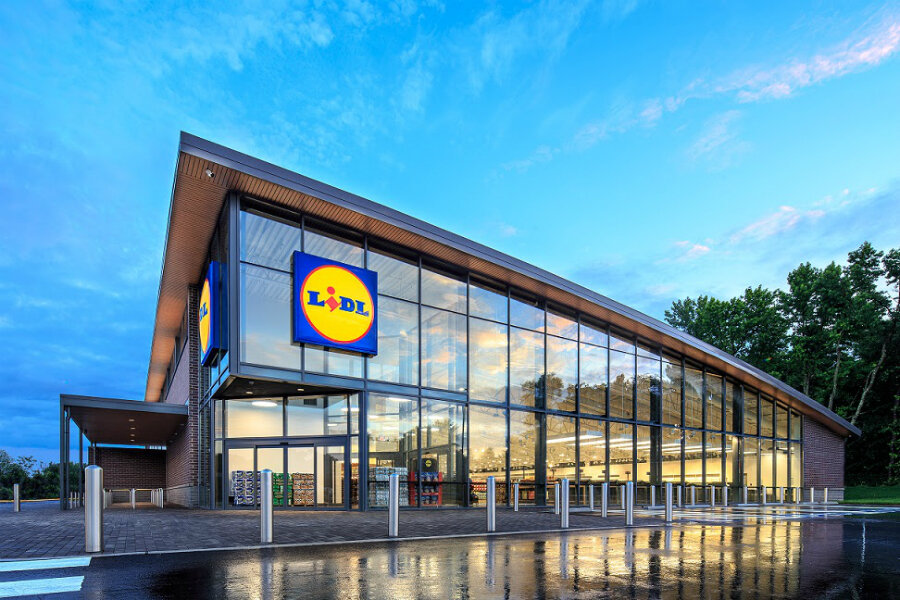Why popular European grocer Lidl is entering the US market
Loading...
A new discount grocer is coming to town. And if its success in Europe is any indication, it might not be long before it comes to a town near you.
Lidl, a 40-year-old German grocery chain owned by Schwarz Group, Europe’s largest retailer and one of the biggest globally, announced Wednesday that it will open 20 stores in the United States this year, beginning in Virginia and the Carolinas. By the end of 2018, Lidl plans to open 100 more stores along the East Coast. The company runs 10,000 stores in 27 countries.
The grocer’s mantra in the US market is "high quality at a low price." According to Lidl’s research, says its spokesperson, this combination could use a boost in the US grocery retail business. “There’s too much compromise in the market around those two things,” says Lidl’s Will Harwood.
But Lidl (lee-duhl) says it won’t have to compromise by doing things like offering fewer products and smaller stores to keep prices low while raising food and shopping-experience quality. A smaller selection of products mostly under its own labels will make shopping more convenient and cheap. After all, that strategy has already worked for its German competitor Aldi and for Trader Joe’s, which is owned by a branch of Aldi. Aldi sells about 14,000 items, mostly under its own labels, compared to 30,000 available from various brands at traditional grocery stores.
“They have made it radically simpler, cognitively, to execute a shopping trip,” write analysts from food industry research firm Hartman Group in a 2015 report about Aldi, which came to the US in 1976 and now has 1,600 stores in 35 states. It expects to expand to 2,000 stores by the end of 2018.
Like Aldi and Trader Joe’s, Lidl’s stores will be small by US grocery store standards, at about 36,000 square feet. For comparison, this is half the size of a Kroger store, which is about 77,000 square feet, and twice the size of a typical Trader Joe’s store.
Fewer products and smaller stores also means fewer staff and aisles for customers to snake through in search of one ingredient. Some products, reports The Washington Post, will appear on shelves in the boxes they were shipped in to keep costs down.
“A lot of the supermarkets are so large, it’s a challenge for people to go shopping,” Lidl’s US chief executive Brendan Proctor told the Post. “If I wanted to go in and get a bottle of ketchup – first of all, there are probably about 24 aisles in the store. I have to find what aisle it’s in. I get there, I find that there’s 50 types of ketchup. Who honestly needs 50 types of ketchup? So we can streamline that.”
As it does in Europe, Lidl says it will also carry a rotating selection of discounted home goods in its US stores, ranging from yoga pants to power drills. Every week there will be something different, says Mr. Harwood. “The non-food section is something that we offer in Europe and we find it very, very successful. Customers like to come in and find an element of surprise.” But unlike in Europe, the US stores will offer more of the traditional grocery offerings that Americans are used to, such as bread samples.
As Matt Sargent, senior vice president of retail at market research firm Frank N. Magid Associates points out, the Lidl approach in the US is part of a larger movement in retail. Companies such as Whole Foods, Wal-Mart, and Target – and even Amazon – all are testing small-store models to compete in a shopping landscape that is increasingly urban, discounted, and online.
Sales at grocers with smaller, more curated stores were expected to grow at an impressive 6 percent per year between 2013 and 2018, according to research cited by Food Navigator. This is behind only grocery stores that specialize in fresh foods (12 percent annually), such as Sprouts and the Fresh Market, and e-commerce grocers (9.5 percent). Sales growth for traditional supermarkets, on the other hand, were expected to grow by only by half a percent annually.
Given these numbers, it's no surprise that food retailers have been eager to downsize. “Everyone wants to be smaller, more efficient, and closer to the customer,” says Mr. Sargent.
While sales at it’s traditional stores have been declining for nearly two years, Whole Foods’s new 365 stores – smaller, more curated, and cheaper – so far appear to be successful, according to the company’s co-CEO John Mackey.
“I do think we’re going to have a lot of those stores,” he told the audience at a June conference in Boston, according to Food Navigator. “They have such superior economics, because you’re taking your capital down 50 percent to two-thirds where [a standard] Whole Foods market is.... So if you get anything close to Whole Foods market’s sales per square foot, the economics are astounding.”
[Editor's note: This story was updated to clarify Aldi's relationship to Trader Joe's.]






